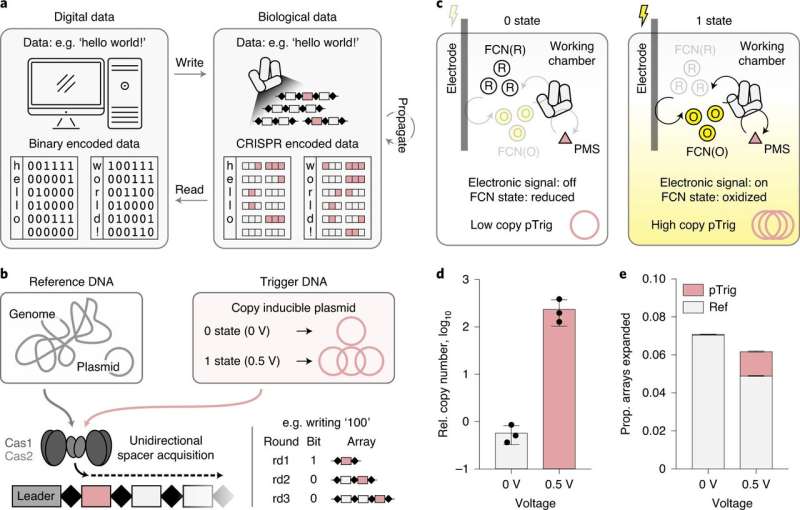January 12, 2021 report
Using electricity to increase the amount of data that can be stored by DNA

A team of researchers at Columbia University has developed a way to allow DNA strands to store more data. In their study, published in the journal Science, the group applied a small amount of electricity to DNA strands to allow for encoding more information than was possible with other methods.
For several years, researchers have been looking for ways to increase data storage capacity—storage requirements are expected to exceed capacity in the near future as demand skyrockets. One such approach has involved encoding data into strands of DNA—prior research has shown that it is possible. In the early stages of such research, scientists manually edited strands to add characteristics to represent zeroes or ones. More recently, researchers have used the CRISPR gene editing tool. Most such studies used DNA extracted from the tissue of deceased animals. More recently, researchers have begun efforts to move the research to living animals because it will last longer. And not just in the edited strands—the information they contain could conceivably be passed on to offspring, allowing data to be stored for very long periods of time.
Back in 2017, another team at Columbia University used CRISPR to detect a certain signal—in their case, it was the presence of sugar molecules. Adding such molecules resulted in gene expressions of plasmid DNA. Over time, the editing process was improved as genetic bits were added to represent ones and zeroes. Unfortunately, the system only allowed for storing a few bits of data.
In this new effort, the researchers have improved on the system using a small current of electricity. Their approach involved using CRISPR to add genes to an E. Coli DNA strand that allowed the cells to increase the amount of plasmid produced when a small amount of voltage was applied. Increases in expression meant increases in the amount of data that could be stored. Using their system, the researchers encoded the words "Hello World" into a bit of E. Coli and then mixed it into a natural soil sample. After the bacteria had multiplied, the researchers found that they could read their message. The researchers acknowledge that their approach is still in a very early stage of testing, but plan to keep at it to improve data capacity.
More information: Sung Sun Yim et al. Robust direct digital-to-biological data storage in living cells, Nature Chemical Biology (2021). DOI: 10.1038/s41589-020-00711-4
Journal information: Nature Chemical Biology , Science
© 2021 Science X Network





















